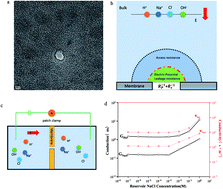Electric control of ionic transport in sub-nm nanopores†
Abstract
The ion transport behavior through sub-nm nanopores (length (L) ≈ radius (R)) on a film is different from that in nanochannels (L ≫ R), and even more different from the bulk behavior. The many intriguing phenomena in ionic transport are the key to the design and fabrication of solid-state nanofluidic devices. However, ion transport through sub-nm nanopores is not yet clearly understood. We investigate the ionic transport behavior of sub-nm nanopores from the perspective of conductance via molecular dynamics (MD) and experimental methods. Under the action of surface charge, the average ion concentration inside the nanopore is much higher than the bulk value. It is found that 100 mM is the transition point between the surface-charge-governed and the bulk behavior regimes, which is different from the transition point for nanochannels (10 mM). Moreover, by investigating the access, pores, surface charge, electroosmosis and potential leakage conductance, it is found that the conductive properties of the nanopore at low bulk concentration are determined by the surface charge potential leaks into the reservoir. Specifically, there is a huge increase in cation mobility through a cylindrical nanopore, which implies potential applications for the fast charging of supercapacitors and batteries. Sub-nm nanopores also show a strong selectivity toward Na+, and a strong repellence toward Cl−. These conclusions presented here will be useful not only in understanding the behavior of ion transport, but also in the design of nanofluidic devices.



 Please wait while we load your content...
Please wait while we load your content...